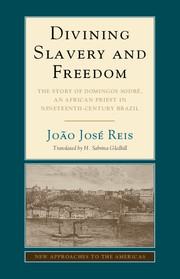 Divining Slavery and Freedom
Divining Slavery and Freedom Book contents
- Frontmatter
- Dedication
- Contents
- Preface
- Abbreviations
- Map
- 1 Cops and Candomblé in Domingos Sodré's Day
- 2 From an African in Onim to a Slave in Bahia
- 3 Domingos Sodré, Diviner
- 4 Witchcraft and Slavery
- 5 Witchcraft and Manumission
- 6 Meet Some Friends of Domingos Sodré
- 7 Domingos Sodré, Ladino Man of Means
- Epilogue
- Timeline of Domingos Sodré's Life
- Glossary
- Appendix 1 Domingos Sodré's Last Will and Testament (1882)
- Appendix 2 Domingos' Manumission and Manumissions Granted by Him
- Appendix 3 Delfina's Petition Guaranteeing Her Mental Health
- Illustration and Map Credits
- Bibliography
- Acknowledgments
- Name Index
- Subject Index
3 - Domingos Sodré, Diviner
Published online by Cambridge University Press: 05 May 2015
- Frontmatter
- Dedication
- Contents
- Preface
- Abbreviations
- Map
- 1 Cops and Candomblé in Domingos Sodré's Day
- 2 From an African in Onim to a Slave in Bahia
- 3 Domingos Sodré, Diviner
- 4 Witchcraft and Slavery
- 5 Witchcraft and Manumission
- 6 Meet Some Friends of Domingos Sodré
- 7 Domingos Sodré, Ladino Man of Means
- Epilogue
- Timeline of Domingos Sodré's Life
- Glossary
- Appendix 1 Domingos Sodré's Last Will and Testament (1882)
- Appendix 2 Domingos' Manumission and Manumissions Granted by Him
- Appendix 3 Delfina's Petition Guaranteeing Her Mental Health
- Illustration and Map Credits
- Bibliography
- Acknowledgments
- Name Index
- Subject Index
Summary
Domingos' HOME, PARISH, AND CITY
The police chief, João Antônio de Araújo Freitas Henriques, took the complaint from customs official José Egídio Nabuco against Domingos Sodré's candomblé very seriously. Chief Henriques ordered a raid headed by Pompílio Manoel de Castro, the acting subdelegado of São Pedro Velho parish, where Domingos lived. The subdelegado was accompanied by two constables, José Thomas Muniz Barreto, a small jeweler, and Adriano Pinto, whose occupation I have been unable to ascertain. He was a neighbor of the African freedman. In addition to these men, the officials present during the search included Lieutenant Colonel Domingos José Freire de Carvalho, none other than the commander of the police, which would supply the physical force for the operation – each officer would be armed with a rifle and a pistol – as the subdelegados, as a rule, did not have any armed police under their command. The entire operation reflects how seriously the chief of police had taken the complaint.
The complainant had sent Chief João Henriques detailed information about where to find Domingos Sodré. He lived in a two-story townhouse on 7 Ladeira de Santa Tereza, a narrow, sloping street connecting Rua de Baixo de São Bento (now Rua Carlos Gomes) and Rua do Sodré, which was named after Domingos' master's family. From the corner of Ladeira de Santa Tereza and Rua do Sodré, the freedman could have seen the eighteenth-century manor that once had belonged to the Sodré family and was now the home of the famous abolitionist poet Antonio de Castro Alves's family. It was just a short distance away, which means that the poet and the freedman were neighbors. Even if they were unaware of each other's existence, the slaves in the abolitionist's household – namely two litter bearers, Augusto and Pedro, a cook, Martinha, and a maid, Vitória, all of whom were African, and a creole washerwoman, Lucrecia – probably knew Domingos and heard about his arrest in 1862. They may even have witnessed the commotion that the incident must have caused.
- Type
- Chapter
- Information
- Divining Slavery and FreedomThe Story of Domingos Sodré, an African Priest in Nineteenth-Century Brazil, pp. 75 - 125Publisher: Cambridge University PressPrint publication year: 2015
